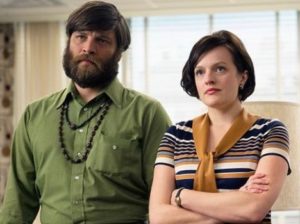Why Content Writers and Web Designers Should Be Friends
“Cut the copy.”
“Shrink the art.”
“Cut the copy!”
“Shrink the art!”
And so it goes. The eternal struggle between artist and writer.
Prime Mover or Prima Donna?
 Years ago, in the prehistoric world of print advertising, a copywriter and an art director nearly came to blows. Seeing all of the space available to the right of a single fashion figure, and feeling the column of type to the left looked crowded, I slid the headline into the wide open space, (which was easy to do, now that we were outfitted with brand new iMacs.)
Years ago, in the prehistoric world of print advertising, a copywriter and an art director nearly came to blows. Seeing all of the space available to the right of a single fashion figure, and feeling the column of type to the left looked crowded, I slid the headline into the wide open space, (which was easy to do, now that we were outfitted with brand new iMacs.)
Mistake!
“Who moved my type?” The art director sounded more like a bass drum as he stomped down the hall. “Who the (bleep) moved my (bleeping) type?”
I raised my hand timidly to a booming (condescending) voice, “You didn’t go through four years of Parsons!”
Okay, I admit it. Most of the time, it was a one-sided fight.
Artists Can’t Spell, Writers Can’t Draw and Nobody Reads the Copy

Let’s dispense with the mean-spirited myths. It’s tempting and tidy to pigeonhole the two professions into right-brain and left-brain cliches. Writers are uniquely possessed of logic and critical thinking. Web designers are innately endowed with creative thinking and visual dexterity. These suppositions serve to separate the skills when, in truth, both types have valuable crossover online marketing experiences.
The relationship between web designer and copywriter is sometimes like, “Which came first: The chicken or the egg?” Did the design give birth to the tone and tenor of site content? Or did the narrative of brand building drive the look and layout of all other elements? Depends on who you ask, the writer or the artist. Sure, a picture’s worth a thousand words, but it’s the caption or accompanying text that allows you to harness the power of visuals to your advantage. None of the graphics are going to define your company’s search terms and help someone find your website. I’m just sayin’.
Why Be Adversaries When You Can Be Advocates?
 Big ad agencies used to sequester an artist and writer in the same office and demand they work late into the night to produce something stellar? They weren’t just making all that Mad Men stuff up. It really happened!
Big ad agencies used to sequester an artist and writer in the same office and demand they work late into the night to produce something stellar? They weren’t just making all that Mad Men stuff up. It really happened!
Now that I’m a content writer, working remotely most of the time, I rarely see the person who illustrates my blogs, social posts and site content. But in any setting, actual or virtual, the need for face-to-face (or Facetime) creative collaboration is crucial from initial ideas through implementation. Teamwork may sound trite, but that’s a term constantly worth redefining. Both writer and designer need to leave their egos out of it, keep an open mind and trust the process. The client will benefit from this meeting of minds.
The Age Old War Between Pretty and Precise
The selection and placement of type may be an important design element but lorem ipsum a good ad does not make. From award-winning headlines to catchy slogans to color names, keywords and product skus, copywriters ensure accuracy. They check facts, back up claims and avoid lawsuits. So, where does the division of labor occur and is it a division at all? The question is how can the two achieve the best outcome? And the answer is: working in harmony.
If the process of website design involves both experts from the beginning, a number of benefits occur. The content writer isn’t made to feel as if the writing is an afterthought. And the web designer doesn’t have to wait on the finalized, approved copy. Both contributors can share their ideas for enhanced user interface by reviewing past projects and utilizing that knowledge to help each other. Right away, concepts can be nurtured or negotiated to avoid surprises and disappointment. It’s important they ask for each other’s opinion of what’s right and what might be wrong for the particular project.
When Writer and Designer Are on the Same Page, It’s a Beautiful Thing

Whether they’re the chicken or the egg, (I’m determined to make this metaphor work,) they wouldn’t be here without each other. They should show a little admiration and acknowledge the strengths each brings to the barn:
Web Design
- Sites with pictures get more page views
- Graphics hold attention longer
- Brains can process visual data faster than words
- Infographics increase engagement
- Visual content is more likely to be shared on social media
Copywriting
- Builds authority through facts
- Tells a complete story with features and benefits
- Creates understanding
- Search engines reward useful, original and optimized content
- Influences behavior, persuades and forms a connection
- Explains how the products work
- Becomes your virtual salesperson
- Rolls out the next step (call to action)
Two Constants: Words and Pictures

In the modern workplace, the terminology may have changed but the tasks haven’t. Outlines became information architecture. Page sequencing became site hierarchy. Layouts became wireframing. Captions and folios became microcopy. But, behind the new nomenclature, there are still text and graphics (words and pictures). Being up on the latest technological breakthroughs is important, but first, there has to be a unified understanding of what’s right for the website.
When web designers and content writers put their heads together (and their dukes down), the outcome can be prize-winning. Pairing these two creative professionals results in exciting visuals and engaging verbalizations. And when art and copy work together, the successful results are measurable. That’s how we do it at iwebcontent. We take the boxing gloves off and together, fight for our clients.






